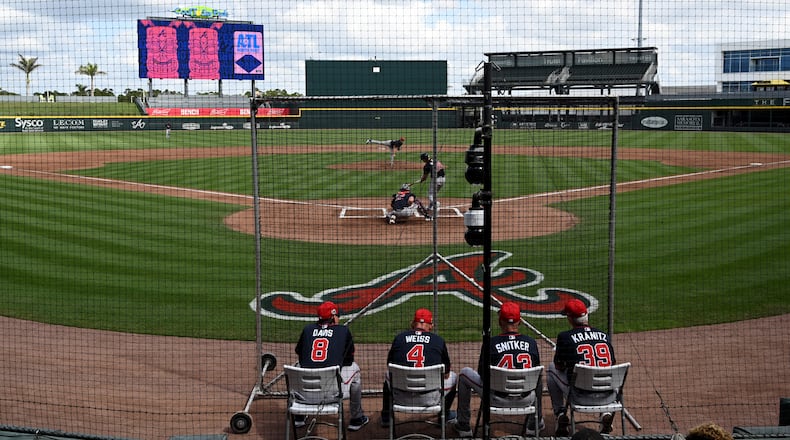NORTH PORT, Fla. — The Braves are scheduled to play 30 spring training games before opening day. The games aren’t official. That doesn’t mean they don’t matter.
For one thing, analysts have found that some spring training statistics have limited predictive for the regular season. Pay particular attention to rates of walks, strikeouts and extra-base hits for pitchers and hitters. Those numbers are particularly relevant for young players who are trying to prove they belong in the big leagues. Also, defense is defense no matter the level of competition.
Those are general reasons to pay attention to what Braves players do in spring training games. The team also have some specific issues to figure out. The first of 26 Braves spring game available for television or streaming is Sunday against the Rays. Here are five things to watch for in their exhibition games:
1. The back end of the starting rotation
Normally, this isn’t a big concern for a team with two starters as good as 2024 NL Cy Young Award winner Chris Sale and 2023 MLB strikeout leader Spencer Strider. But Sale turns 36 years old next month and topped 150 innings last year for the first time since 2018. Strider won’t be on the opening-day roster as he recovers from elbow surgery. Also, converted reliever Reynaldo López could be due for regression after he was great in 25 starts (135⅔ total innings) last season.
The rotation needs depth for insurance. Ian Anderson and Grant Holmes are projected to fill the final two spots, but Braves manager Brian Snitker said the team’s decision-makers would consider performance in spring training games. AJ Smith-Shawver heads the list of candidates who could make a bid for the rotation with good outings this spring. There’s a chance the Braves will sign a veteran pitcher if they don’t like what they see from the current candidates.
3. Matt Olson’s power
It’s not as if Olson suddenly lost the ability to hit home runs. He knocked 29 homers in 2024. But that came after he hit 54 in 2023. It tends to raise questions when he follows that with his lowest homer total in a 162-game season since he became a regular with the Athletics in 2018. Per Statcast tracking data, last season Olson swung at the highest percentage of pitches outside of the strike zone in his career and produced the lowest average exit velocity on batted balls since his debut season of 2018 (he played only 11 games that season).
It didn’t seem to matter when Olson hit just one home run over 44 at-bats last spring. Another power-less exhibition campaign wouldn’t necessarily mean he’s headed for another low homer total by his standards. But it’s worth watching Olson in spring games to see how often and how hard he makes contract.
3. The candidates to pitch high-leverage innings in the bullpen
It seems this topic concerns other outside observers more than it does me. I always assume the Braves will figure out the bullpen even when it looks like a problem, and I’ve usually been proved right. Relievers always are available in trades, after all. But it’s possible the Braves will be caught short on quality bullpen arms this year, with superb setup man Joe Jimenez likely out for the season after undergoing knee surgery in October.
I think right-hander Pierce Johnson and lefty Aaron Bummer will handle the job just fine. Dylan Lee is a solid option if needed. There are even plausible choices deeper in the bullpen. Angel Perdomo did OK while handling high-leverage innings for the Pirates in 2023, and Conyers native Buck Farmer had a 3.04 ERA over 71 innings for the Reds last season.
4. The candidates to fill out the bench
Braves starters tend to play every day, so playing time for reserves is limited so long as the regulars stay in good health. That didn’t happen last season. Five Braves regulars had lengthy stays on the injured list in 2024, and contributions from reserves helped the team stay afloat. The Braves will have a new mix of reserves to begin this season. Two bench players from opening day last year, Forrest Wall and Luis Guillorme, no longer are on the roster.
This year, the competition for bench spots includes offseason signees Bryan De la Cruz and Nick Allen plus holdover Luke Williams. Outfielder De La Cruz has the best offensive track record among the group. Williams is the most versatile — he’s played every outfield position plus second and third base at the major-league level. Allen already has gotten notice from Braves manager Brian Snitker, who noted that it’s “maybe been a while that we’ve had a defensive compliment like that.”
5. Jurickson Profar’s defense
New addition Profar should help the Braves with his bat even if he can’t sustain his power surge from last season. Profar always has made good contact. That will be useful in a lineup full of swing-and-miss sluggers that too often left base runners stranded last season. But Profar, who projects as the everyday right fielder on opening day, arrives with questions about his defensive ability.
All the major defensive metrics agree that Profar isn’t good in the outfield. He’s posted a negative defensive WAR (Baseball Reference) in his past three seasons as an outfield regular. StatCast ranks Profar low among outfielders in arm strength and range. Having a below-average right fielder needn’t be a fatal flaw — the Braves got away with it when Jorge Soler was out there — but it would be reassuring if Profar looks good in the field this spring.
About the Author
Keep Reading
The Latest
Featured


